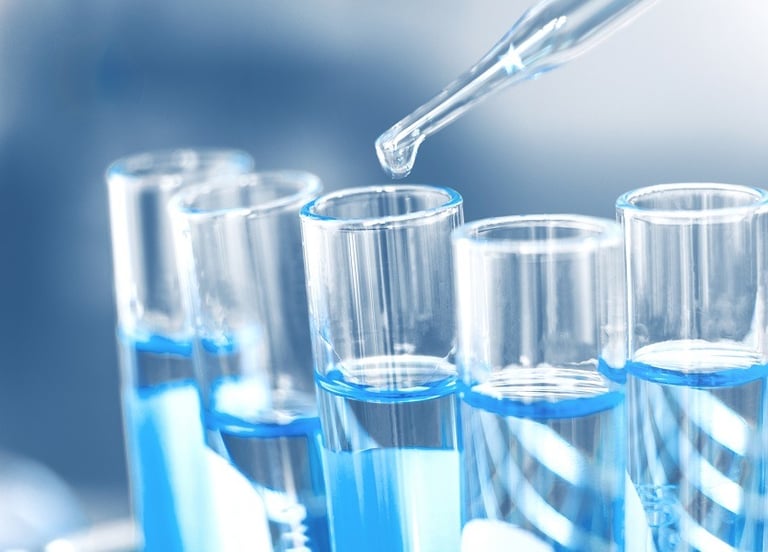
WATER TESTS AND ANALYSES
Water tests and analyses are various chemical, physical, microbiological, and radiological examinations conducted to determine the quality, safety, and suitability of water for a specific use. These tests can be applied to different water sources such as drinking water, wastewater, industrial water, surface waters (rivers, lakes, seas), and groundwater.
The main objectives of water tests and analyses are:
Protecting human health: Ensuring that drinking water is safe.
Protecting the environment: Ensuring that wastewater is discharged without harming the environment.
Meeting industrial needs: Providing the required water quality for specific industries.
Ensuring compliance with legal regulations: Verifying compliance with local and international standards related to water quality.
Water tests and analyses can generally be categorized as follows:
1. Physical Tests and Analyses:
Temperature: Measuring the temperature of the water.
Color: Determining the color of the water visually or spectrophotometrically.
Turbidity: Measuring the cloudiness caused by suspended particles in the water nephelometrically.
Odor and Taste: Evaluating the odor and taste characteristics of the water sensorially.
pH: Measuring the acidity or alkalinity of the water with a pH meter.
Electrical Conductivity (EC): Measuring the electrical conductivity, which is an indicator of the amount of dissolved ions in the water.
Total Dissolved Solids (TDS): Determining the total amount of inorganic and organic substances dissolved in the water.
Suspended Solids (SS): Determining the amount of filterable solid substances suspended in the water.
2. Chemical Tests and Analyses:
Inorganic Parameters:
Hardness: Determining the amount of dissolved calcium and magnesium ions in the water.
Chloride: Determining the amount of dissolved chloride ions in the water.
Sulfate: Determining the amount of dissolved sulfate ions in the water.
Nitrate, Nitrite, Ammonia: Determining the amount of nitrogen compounds in the water (important indicators of pollution).
Fluoride: Determining the amount of dissolved fluoride ions in the water (important for dental health).
Heavy Metals (Lead, Mercury, Cadmium, Chromium, Arsenic, etc.): Determining the amount of heavy metals with toxic effects in the water.
Organic Parameters:
Chemical Oxygen Demand (COD): Determining the amount of oxygen required to chemically oxidize the organic substances in the water.
Biochemical Oxygen Demand (BOD): Determining the amount of oxygen required to biologically decompose the organic substances in the water.
Total Organic Carbon (TOC): Determining the total amount of carbon in the organic compounds present in the water.
Pesticides, Herbicides, Polyaromatic Hydrocarbons (PAHs): Detecting and quantifying agricultural pesticides and industrial pollutants that may be present in the water.
Dissolved Gases:
Dissolved Oxygen (DO): Determining the amount of oxygen dissolved in the water (vital for aquatic life).
Free Chlorine: Determining the amount of free chlorine used for disinfection in drinking water.


Reliable and Comprehensive Solutions in Water Analysis: Why Kompass Europe?
Access to clean and safe water is vital for human health and the environment. Accurate and reliable water analysis plays a key role in ensuring this access. As Kompass Europe, we would like to share with you why we should be the preferred partner in water analysis:
Comprehensive Range of Analyses and Deep Expertise
Latest Technology and International Standards
Fast, Reliable, and Traceable Results
Customer-Focused Approach and Customized Solutions
Confidentiality and Reliability
Continuous Support and Consulting
3. Microbiological Tests and Analyses:
Total Coliform Bacteria: Detecting and counting coliform bacteria, a general indicator of water contamination.
Fecal Coliforms (E. coli): Detecting and counting E. coli bacteria, which are found in the intestines of warm-blooded animals and indicate fecal contamination.
Pathogenic Bacteria: Detecting pathogenic bacteria that can cause diseases, such as Salmonella, Shigella, and Vibrio cholerae.
Viruses: Detecting pathogenic viruses that may be present in the water, such as hepatitis A virus and rotavirus.
Parasites: Detecting parasites that may be present in the water, such as Giardia and Cryptosporidium.
4. Radiological Tests and Analyses:
Alpha and Beta Radioactivity Measurement: Measuring the activity of alpha and beta radiation emitted by radioactive substances in the water.
Radionuclide Analysis: Detecting and quantifying specific radioactive isotopes (e.g., Uranium, Radium) present in the water.
Contact Us for Your Water Testing and Analysis.
We offer affordable and effective solutions tailored to your needs.
The information presented on this website does not constitute legal advice and is intended for informational purposes only. KompassEurope.com.tr assumes no responsibility for any errors or omissions in the information contained on this website. Any decisions made or actions taken by the reader based on this information are solely at the reader's own risk, and KompassEurope.com.tr shall not be held liable for any legal consequences arising from such decisions or actions. Readers are strongly advised to seek professional legal counsel regarding their specific circumstances and concerns.
© 2025 Kompass Europe. All rights reserved. The contents of this website belong to Kompass Europe and are protected by copyright laws. Copying, publishing, distributing or any commercial use of the information on the website is possible only with written permission. By using this site, you agree to our Terms of Use and Privacy Policy.
